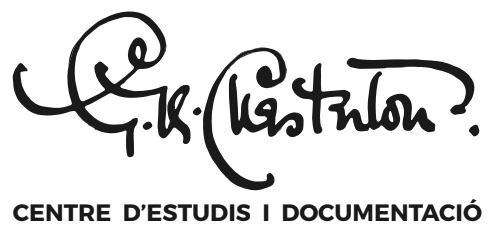Glossary
The glossary includes essential terms related to the person, life, and work of Chesterton. For reasons of space it must inevitably be incomplete. It includes the most important people – family, friends, contemporaries and adversaries -, the most significant places – streets, neighborhoods, buildings, literary, cultural and religious associations – and the most important public activities – conferences, debates, meetings, congresses , election campaigns and travel.
There are currently 16 terms in this directory beginning with the letter C.
Café Royal
Located at 68 Regent’s Street (Piccadilly Circus, London); café frequented by Gilbert before lunch.
Campden Hill
Hill in Kensington, West London, which limits Holland Park Avenue to the north, Kensington High Street to the south, Kensington Palace Gardens to the east and Abbotsbury Road to the west; this urban site was part of Chesterton’s childhood, especially St. George’s Church and Waterworks Tower.
Chesterbelloc
Bernard Shaw gave friends Chesterton and Belloc this name in an article titled “The Chesterbelloc: A Lampoon”, published in The New Age on the 15th of February 1908.
Chesterton, Ada (1888-1962)
Journalist, writer and social activist; in 1927 she founded the Cecil Houses; married with Cecil Chesterton; née Ada Jones; pseudonym John Keith Prothero; together with Ralph Neale she wrote a stage version of the novel The Man Who Knew Too Much (1926) which premiered on 19 January of the same year at the Everyman Theatre (Hampstead, London).
Chesterton, Beatrice (1870-1878)
Older sister of Gilbert and Cecil; she died when she was eight years old; she’s buried in the same tomb as her parents, Edward and Marie Louise, in Brompton cemetery (Kensington, London).
Chesterton, Cecil (1879-1918)
Journalist and writer; Beatrice and Gilbert’s brother; he was an active member of the Fabian society; in 1912 he converted to Catholicism and in 1916 he married Ada Jones; he worked with Belloc in The Eye Witness; he exposed the Marconi scandal and though one of the accused, Godfrey Isaacs, brought him to trial but the compensation was minimal; founder and theorist of distributism; he died during the First World War; he’s buried in the British cemetery of Terlincthun, north of Boulogne-sur-Mer (Pas-de-Calais).
Chesterton, Edward (1841-1922)
Co-owner, with his brother Arthur, of the estate agency Chesterton & Sons of Kensington (London); married to Marie Louise Grosjean; father of Beatrice, Gilbert and Cecil.
Chesterton, Frances (1869-1938)
Verse and song writer and author of school plays; she worked as a secretary at the PNEU (The Parents’ National Educational Union, London); married to Gilbert Keith Chesterton; after having surgery in 1908 to improve her fertility, the next year she has to accept she won’t be able to have children; on 1 November 1926 she converts to Catholicism.
Chesterton, Marie Louise (1844-1933)
Married to Edward Chesterton; mother of Beatrice, Gilbert and Cecil; née Marie Louise Grosjean.
Christian Social Union, The
Organization in partnership with the Church of England; though Anglo-Catholic from a spiritual point of view, it combined traditional beliefs with revolutionary politics; it was an association that dumbfounded both the Labour Party and the Anglican hierarchy; Gilbert and Frances collaborated in many CSU activities, together with Reverend Conrad Noel and Member of Parliament C.F.G. Masterman.
Church Congress
Church of England congress held in Liverpool in October 1904; at Hope Hall, under the presidency of the bishop of Liverpool, the subject of Christian Evidences was discussed; Chesterton provided one of the most interesting interventions.
Clarion, The
Socialist weekly published by Robert Blatchford; its political perspective was more British centred than internationalist; the controversy maintained in its pages between Chesterton and Blatchford lasted nearly two years (1903-1904).
Colet Court
Prep school located in Hammersmith (London) where Gilbert took his primary education in the period 1881-1886.
Collins, Dorothy (1894-1988)
Gilbert’s secretary since 1926; through the years she would end up being a part of the family; in 1931 she converted to Catholicism; she edited, compiled and prologued Chesterton’s posthumous works; she’s buried with Gilbert and Frances in Shepherds Lane cemetery (Beaconsfield, Buckinghamshire).
Contemporary journalism
Going beyond the assembling and publishing of the latest news, the contemporary journalism which was born in the late 19th century was a powerful tool of social and cultural cohesion; it helped to systematically unify local, national and international news, and it served as a platform to forge a culture of opinion, dialogue, and debate; the quality of the periodicals and of its columnists in this first period of contemporary journalism was due to the close relationship between journalism and the literary world.
